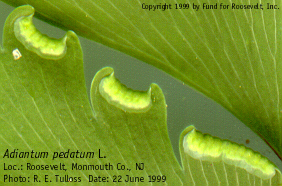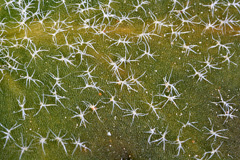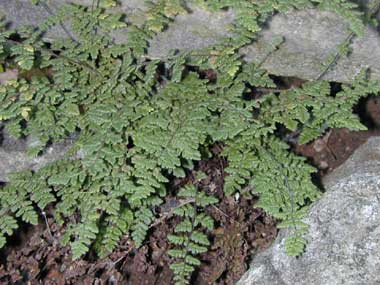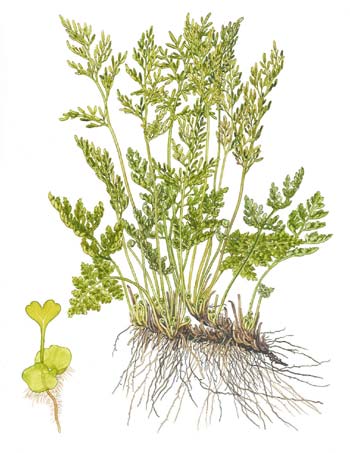|
Hardy Fern Home All Ferns Fern Families ��Aspleniaceae ��Blechnaceae ��Dennstaedtiaceae ��Dryopteridaceae ��Lygodiaceae ��Osmundaceae ��Polypodiaceae ��Pteridaceae ��Thelypteridaceae ��Woodsiaceae Fern Genera ��Adiantum ��Arachniodes ��Aspidotis ��Asplenium ��Astrolepis ��Athyrium ��Blechnum ��Cheilanthes ��Cryptogramma ��Cyrtomium ��Cystopteris ��Dennstaedtia ��Deparia ��Diplazium ��Dryopteris ��Gymnocarpium ��Lygodium ��Matteuccia ��Onoclea ��Oreopteris ��Osmunda ��Pellaea ��Phegopteris ��Pleopeltis ��Polypodium ��Polystichum ��Pteridium ��Pteris ��Pyrrosia ��Thelypteris ��Woodsia ��Woodwardia |
| Pteridaceae | ||
|
Submarginal sori that lack indusia or are protected by a reflexed or revolute leaf margin. Here 7
genera. | ||
| Adiantum | ||
Maidenhair fern | ||
|
Etymology
Adiantum is from the Greek, adiantos, meaning unwettable, referring to the water-repellent fronds.
Description
Rhizome: suberect to long-creeping, absent or hairy or scaly.
Frond: deciduous, monomorphic. Stipe: chestnut brown to dark purple, grooved above, glabrous or few scales, vascular bundles: 1 or 2. Blade: 1-3 pinnate or pedate, lanceolate, ovate, trowel-shaped, or fan-shaped, membranaceous to papery, commonly glabrous. segments round, fan-shaped, rhombic, or oblong with marginal teeth, lacking a midrib, veins free, forking. Sori: sporangia, submarginal, indusium: false, inrolled margins, sporangia: yellow or yellowish brown.
Distinctive Characteristics
FNA states that sporangia borne on the lower surface of the false indusium are both necessary and sufficient to define the genus. However, lacking a high-powered lens, the amateur will need additional criteria. The lack of a midrib in the ultimate segments is unique among the hardy ferns here.
|
|
|
| Aspidotis | ||
Lace fern | ||
|
Etymology
From the Greek aspidotes, shield-bearer, referring to the shield-like false indusia.
Description
Rhizome: short-creeping, scales brown to black or often bicolored with dark central stripe.
Frond: evergreen, monomorphic or nearly so. Stipe: dark reddish brown, with single groove, glabrous, vascular bundles: 1. Blade: 3-pinnate at base, or more, triangular, leathery , glabrous. segments linear, veins obscure, free. Sori: sporangia, submarginal, continuous along length of segments except at apex, indusium: false, inrolled margin, broad, thin, dry, sporangia: dark brown.
Distinctive Characteristics
Separated from Cheilanthes based on its elongate, distantly dentate, glabrous, pointed segments with striate shining surface and on its broad, thin, dry indusia.
|
|
|
| Astrolepis | ||
Star-scaled cloak fern | ||
|
Etymology
Greek: Astro, star + lepis, scale. This refers to the starlike scales on the upper blade surface.
Description
Rhizome: short-creeping, scales tan to chestnut brown, linear.
Frond: evergreen, monomorphic. Stipe: dull chestnut brown or straw-colored, rounded above, scaly, vascular bundles: 2. Blade: 1-pinnate, the pinnae varying from lobed to pinnatifid, linear, leathery, star-shaped scales on the upper surface. Pinnae: 3-6 lobes per pinna, veins obscure, free, forking. Sori: clustered near notches between pinna lobes, along veins near margin, indusium: absent, sporangia: light to dark brown.
Distinctive Characteristics
The combination of linear, pinnate leaves, two vascular bundles in the petioles, and unique star-like scales on the upper blade surface separate Astrolepis from the related Cheilanthes.
|
|
|
| Cheilanthes | ||
Lip fern | ||
|
Etymology
Greek: From cheilos, lip + anthos, flower. A lip-like false indusium covers the sporangia.
Description
Rhizome: erect to long-creeping, scales brown to black or often bicolored with dark central stripe.
Frond: evergreen, monomorphic. Stipe: brown to black or straw-colored, rounded, flattened, or with single longitudinal groove above, hairy, scaly, or glabrous, vascular bundles: 1. Blade: pinnate-pinnatifid to 4-pinnate at base, leathery or rarely somewhat herbaceous, finely hairy and/or scaly below, finely hairy or glabrous above. segments entire, stalked or sessile, fertile segment margins slightly enrolled to cover sporangia, veins free. Sori: sporangia, submarginal, indusium: false, sporangia: brown to black or gray. |
|
|
| Cryptogramma | ||
Parsley fern | ||
|
Etymology
Greek: kryptos, hidden + gramme, line. The reflexed leaf margin hides the line of sori.
Description
Rhizome: erect to creeping, scales colorless or brownish, concolored or bicolored, ovate, lanceolate or linear.
Frond: deciduous or evergreen, dimorphic. Stipe: dark brown proximally, light brown to green distally, with single longitudinal groove above, scaly, vascular bundles: 2. Blade: 2-3 pinnate, deltate, lanceolate to elliptic, somewhat leathery or herbaceous to membranaceous, glabrous or sparsely hairy above, glabrous below. segments sterile: toothed, veins free. Sori: scattered along veins, submarginal, indusium: false, strongly enrolled, sporangia: yellow. |
|
|
| Pellaea | ||
Cliff brake | ||
|
Etymology
From the Greek pellos, dusky, describing the bluish-gray coloring.
Description
Rhizome: short to long-creeping, bicolorous scales with a central stripe or brown.
Frond: evergreen, monomorphic to somewhat dimorphic. Stipe: dark, shiny, rounded, flattened or with single longitudinal groove above, glabrous or pubescent, usually with a few scales at base, vascular bundles: 1. Blade: 1-3 pinnate with terminal leaflet, linear to ovate-deltate, leathery or rarely somewhat herbaceous, below glabrous, pubescent, or with hairlike scales scattered along costae, above usually glabrous. segments broad, stalked or sessile, veins free or rarely netted. Sori: oblong or linearly joined, submarginal, indusium: absent or false, sporangia: brown.
Distinctive Characteristics
dark, shiny stipes, 1-(or 2- or 3-)pinnately-divided blades with a terminal leaflet, and a false indusium.
|
|
|
| Pteris | ||
Brake fern | ||
|
Etymology
Greek: from pteron, a wing, referring to the shape of the pinnae, but the word pteris was used by the ancient Greeks for ferns in general..
Description
Rhizome: erect to short-creeping, scales pale brown to black, concolored, elongate.
Frond: deciduous, monomorphic or somewhat dimorphic. Stipe: longitudinally ridged, 2--3-grooved above, scaly at base, glabrous or scaly distally, vascular bundles: 1 or more. Blade: 1-4 pinnate, oblong to lanceolate to deltate, herbaceous to leathery. segments sessile to short-stalked, linear to oblong-lanceolate, veins conspicuous, free. Sori: continuous, submarginal, indusium: false, sporangia: brown. |
|
|






